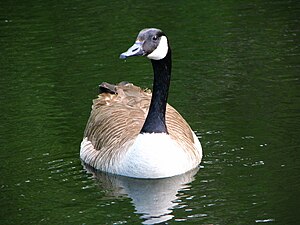Branta
|
Branta Temporal range: Late Miocene-Holocene |
|
|---|---|
 |
|
| A Canada goose (Branta canadensis) swimming at Smythe Park, Toronto, Ontario, Canada | |
| Scientific classification | |
| Kingdom: | Animalia |
| Phylum: | Chordata |
| Class: | Aves |
| Order: | Anseriformes |
| Family: | Anatidae |
| Subfamily: | Anserinae |
| Genus: |
Branta Scopoli, 1769 |
| Species | |
|
Branta bernicla |
|
| Synonyms | |
|
Nesochen Salvadori, 1895 |
|
Branta bernicla
Branta canadensis
Branta hutchinsii
Branta leucopsis
Branta ruficollis
Branta sandvicensis
and see text
Nesochen Salvadori, 1895
The black geese of the genus Branta are waterfowl belonging to the true geese and swans subfamily Anserinae. They occur in the northern coastal regions of the Palearctic and all over North America, migrating to more southernly coasts in winter, and as resident birds in the Hawaiian Islands. Alone in the Southern Hemisphere, a self-sustaining feral population derived from introduced Canada geese is also found in New Zealand.
The scientific name Branta is a Latinised form of Old Norse Brandgás, "burnt (black) goose). The black geese derive their vernacular name for the prominent areas of black coloration found in all species. They can be distinguished from all other true geese by their legs and feet, which are black or very dark grey. Furthermore, they have black bills and large areas of black on the head and neck, with white (ochre in one species) markings that can be used to tell apart most species. As with most geese, their undertail and uppertail coverts are white. They are also on average smaller than other geese, though some very large taxa are known, which rival the swan goose and the black-necked swan in size.
...
Wikipedia
